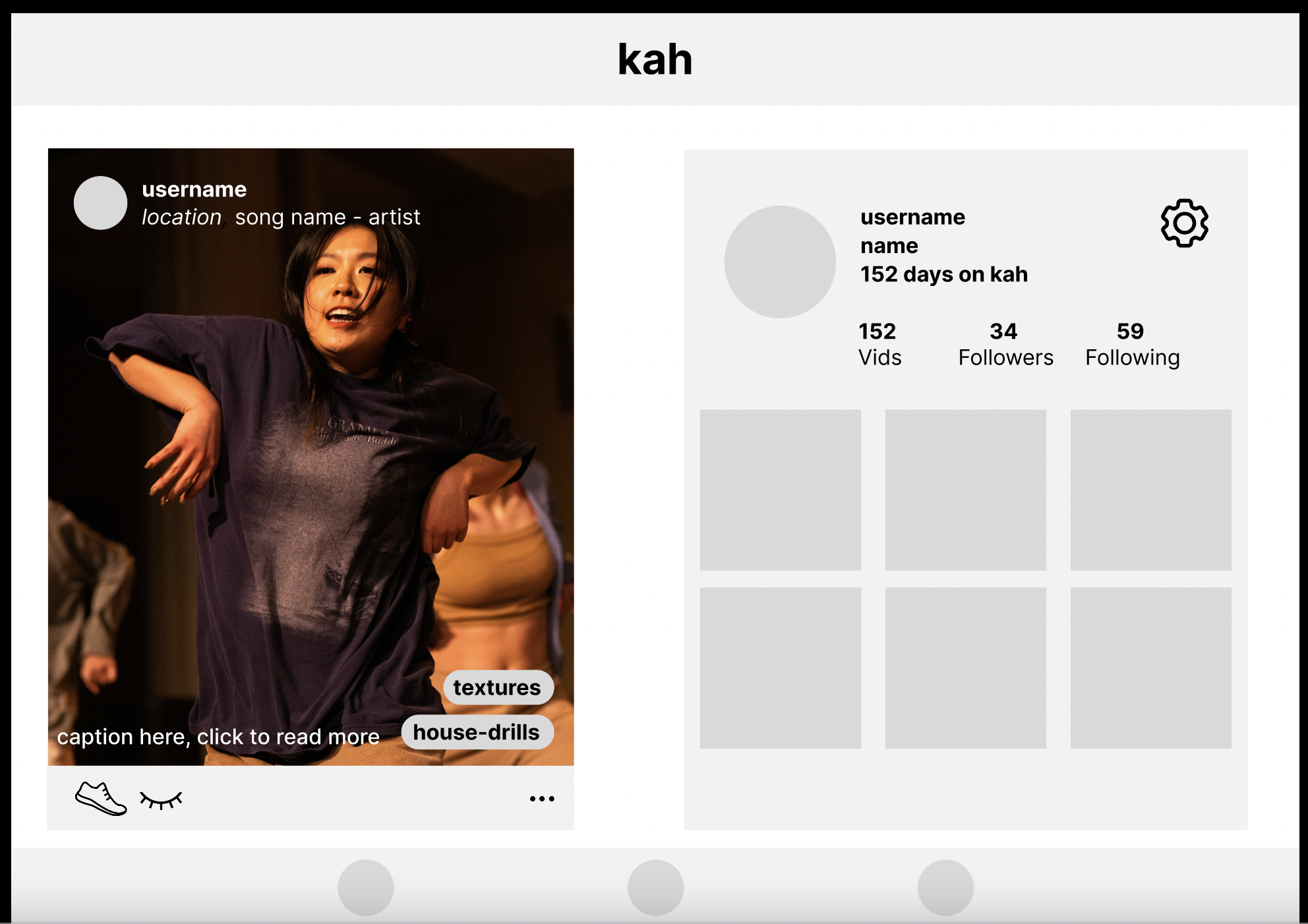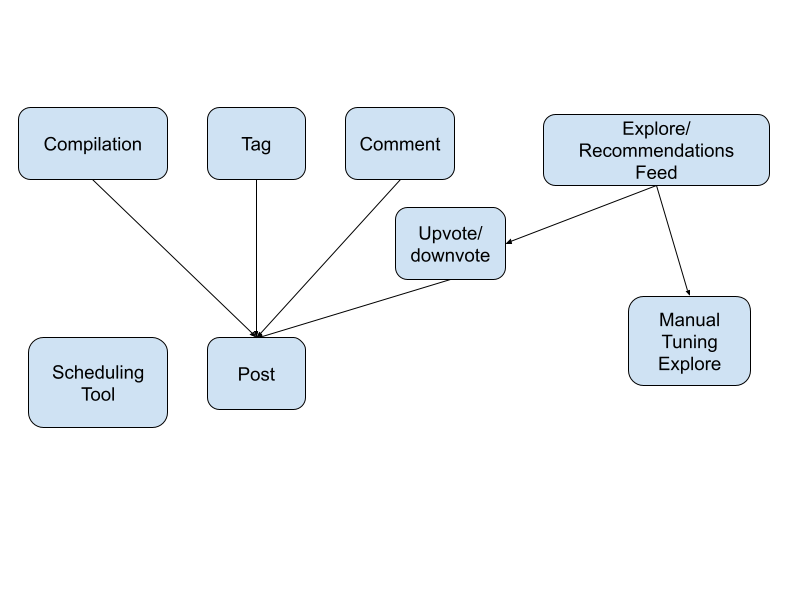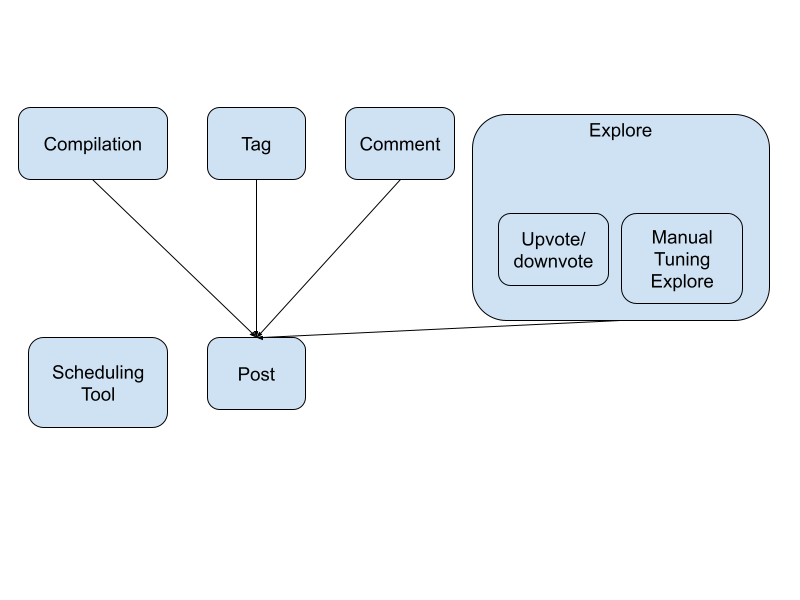A3. Convergent Design
Pitch
Kah, is the sound of a snare dancers say out loud to supplement their counting during practice. Kah, is an app for dancers who want to track their progress and share their videos in a safe space that values learning and community over internet fame and virality.
From my own experience as well as the experiences of the two dancers I interviewed, watching videos of oneself practicing choreography, freestyle, and technique combinations are critical to improving dance: three out of three times being called the most effective way to improve dance fast. Thus, it’s nice to have a system that collects, labels, commemorates and shares this personal journey.
The key functions are: posts (videos), upvote, tag, following, following feed, profile, explore, scheduling, dancer/organizer account type, stories, and compilations. Essentially both dancers and organizers can create accounts and share videos to their followers, and dancers can go on the profile page of organizers. They can consume dance videos from their feed, profile, explore page, or by clicking through tags. Additionally they can control their explore recommendations in their settings: a feature that very intentional artists who care to curate their content consumption might value (Interview 2).
Functional Design
concept Posts
Purpose: share video that can be engaged with
Principle: a user shares a video of dance that is associated with data
(captions, tags, likes, and comments, user) and shows up in their profile
and the feed of other users based on restriction level
State:
Videos: PostID -> Videos
Captions: PostID -> string
Tags: PostID -> {Location: string, Song: string, Accounts: Users, Technique: string}
Likes: PostID -> Users
Comments: PostID -> Comments
Restriction: PostID -> {Public | Private | Personal}
Actions:
// user adds a comment during a session
add_comment(user: Users, body: "string")
Comments.add{Comment(user, body)}
add_like(user)
Likes.add(user)
// user clicks a tag of the post and views collection
get_tag_collection(tag)
change_restriction(newRestriction: Restriction)
Restriction = newRestriction
// based on restrictions, returns the post
render(user)
concept Explore
Purpose: recommend videos for user based on user preferences and upvote history (synchronization).
Principle: user manually sets preferences for different metrics (location, genre,
age, and etc) and gets a personalized method of ranking relevance of
suggested public posts
State:
all_available_posts: Posts
upvote_history: user -> Posts
location_preference: user -> (Number, Number)
genre_preference: user -> tags
age: user -> (Number, Number)
Actions:
// from a set of viable posts, return ranked list of posts by perceived relevance
sort_by_relevance(posts)
concept Tags
Purpose: labels on videos to see in collections of multiple videos
Principle: user issues four types of tags on their own post (song, user,
technique, location) that all users can click to see collections of.
State:
tagCollections: tagID -> Array<PostID>
type: {songs: songs, users: Users, technique: string, location: string}
tagName: tagID -> string
Action:
// return tag collection but only posted by given user
getTagFilteredbyUser(user)
// return tag collection but for all accessible to user in session
getTagCollectionAll()
concept Compilation
Purpose: let users look back at their progress by automating a video compilation of
their posts.
Principle: at time T at the end of the year, all users receive pending post
that contains a video compilation/summary of the users videos, tags, and
user interactions.
State:
compilations: userID -> Video
Action:
// generate compilation for user for last year's posts
generateCompilation(user, date)
concept Scheduler
Purpose: Organizers can add class events to a calendar on their profile, which
students can sign up for (reserve a spot on a first come first serve basis)
Principle: when class event becomes available for sign up, capacity number of
users can register for the class by clicking on the calendar event on the
organizer's
State:
Calendars: OrganizerID
Events: EventID -> OrganizerID
Capacities: EventID -> Capacity
Registration: EventID -> Users
EventDate: EventID -> Date
Action:
// based on capacity, current registration, and event date
isEventAvailable(EventID): True/False
register(EventID, user)
addEvent(user, date, capacity)
concept Comments
Purpose: users can leave nested messages under a post.
Principle: user send a comment on a post or comment.
State:
comment_source: CommentID -> CommentID | PostID
Action:
addComment(user, source: CommentID | PostID)
getComments(PostID): Comments
Wireframes

Design Iterations
Iteration 1: 
Iteration 2: 
Design Tradeoffs
Automated vs. Curated Recommendation
Although discovering new non-regional things is a unique benefit of the internet, some dancers don't like the mindless spew of the algorithm (see interviews). Thus there is a mix of automated (upvote/downvote) and manual recommendation tuning as options.
Tracking Data vs. Comparing Statistics
Followers are displayed but hopefully dancers don't compare each others meaningless statistics.
Showing Approval vs. Doom-scrolling
Throwing shoes are the way of liking on this app. As a display of appreciation, hopefully will get people to scroll more meaningfully. Although the endless feed is part of the toxic doom-scrolling phenonmenon in social media.